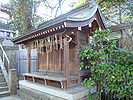Shinto architecture
Shinto architecture is the architecture of Japanese Shinto shrines.
History
changeIn Japan, the practice of designating sacred areas started in the Yayoi period (500 BC - 300 AD) based on the fundamental beliefs of Shintoism. Land features like mountains, waterfalls, rocks, and islands were considered capable of drawing kami and hence were revered as yorishiro..[1]
In the beginning, sacred locations were likely marked with only a fence surrounding the area and a torii gate, at the entrance.[2] Afterwards, temporary structures resembling modern portable shrines were built to receive the deities at the holy site.[3]
As time passed, the temporary structures used to welcome the gods evolved into permanent structures that were dedicated solely to the gods. Ancient shrines were constructed in different styles such as dwellings (for example, Izumo Taisha)[1][4] or storehouses (for example, Ise Grand Shrine).[1][2]
The ancient shrine buildings had gabled roofs, raised floors, plank walls, and were either thatched with reed or covered with hinoki cypress bark..[2] In the past, the early shrines didn't have an area for people to worship..[1] Three important forms of architecture styles exist: taisha-zukuri, shinmei-zukuri, and sumiyoshi-zukuri.[3][5]
Izumo Taisha, Nishina Shinmei Shrine and Sumiyoshi Taisha[6] have each type respectively and were built at or before 552.[7]
The tradition of Shikinen sengū-sai states that buildings or shrines are regularly rebuilt according to the original design. This has been done throughout the centuries to preserve ancient styles up to the present day..[note 1][4][8][9]
Common features
changeThe following is a diagram illustrating the most important elements of a Shinto shrine:
- Torii – Shinto gate
- Stone stairs
- Sandō – the approach to the shrine
- Chozuya or Temizuya – fountain to cleanse one's hands and face
- Tōrō – decorative stone lanterns
- Kagura-den – building dedicated to Nō or the sacred kagura dance
- Shamusho – the shrine's administrative office
- Ema – wooden plaques bearing prayers or wishes
- Setsumatsusha – small auxiliary shrines
- Komainu – the so-called "lion dogs", guardians of the shrine
- Haiden – oratory
- Tamagaki – fence surrounding the honden
- Honden – main hall, enshrining the kami.
- On the roof of the haiden and honden are visible chigi (forked roof finials) and katsuogi (short horizontal logs), both common shrine ornamentations.
Gallery
change-
A metal torii
-
A sandō
-
A temizuya
-
A komainu
-
Izumo Taisha's honden
-
Hanazono Jinja's haiden
-
Kasuga Taisha's heiden
-
Hirairi style: entrance on the non-gabled side
-
The typical shape of the back of a Hiyoshi-zukuri roof
-
A hokora
-
Ōtori-zukuri
-
Ōtori Taisha's honden
-
Some setsumatsusha
-
Shinmei-zukuri
-
Sumiyoshi-zukuri
-
Taisha-zukuri, Izumo Taisha
Related pages
changeNotes
change- ↑ Presently only the Ise Grand Shrine is being rebuilt every 20 years.
References
changeSources
change- Fletcher, Sir Banister; Cruickshank, Dan (1996) [1896]. Sir Banister Fletcher's a history of architecture (20th illustrated ed.). Architectural Press. ISBN 0-7506-2267-9. Retrieved 2009-11-11.
- Kishida, Hideto (2008). Japanese Architecture. READ BOOKS. ISBN 978-1-4437-7281-5. Retrieved 2009-11-11.
- Kuroda, Ryūji (2005-06-02). "History and Typology of Shrine Architecture". Encyclopedia of Shinto (β1.3 ed.). Tokyo: Kokugakuin University. Retrieved 2009-11-16.
- Nishi, Kazuo; Hozumi, Kazuo (1996) [1983]. What is Japanese architecture? (illustrated ed.). Kodansha International. ISBN 4-7700-1992-0. Retrieved 2009-11-11.
- Watanabe, Yasutada (1974). Shinto art: Ise and Izumo shrines. New York, Tokyo: Weatherhill/Heibonsha.
- Young, David; Young, Michiko (2007) [2004]. The art of Japanese architecture. Architecture and Interior Design (illustrated, revised ed.). Tuttle Publishing. ISBN 978-0-8048-3838-2. Retrieved 2009-11-11.





